Henry Warren is a multi-award winning innovation expert and entrepreneur specialising in Education Technology. Read more from our EdTech series.
Tell us about Turn On The Subtitles…
We believe that it’s the most impactful 10 seconds you can ever spend as a parent.
It all starts with this simple fact: Did you know that if you turn on subtitles for kids TV programmes, it dramatically improves literacy? In fact, it doubles the chance of a child leaving school as a proficient reader. We believe that it’s the most impactful 10 seconds you can ever spend as a parent; it’s hard to think of a better one.
There are three parts to the campaign: a campaign to get the broadcast systems to change their default subtitle settings on children’s content, political lobbying focusing on legislation, and public awareness-raising. Most channels already have subtitle tracks, the challenge is changing the default setting, and that default really matters.
How did TOTS come about?
It’s an idea that’s so obvious when you hear about it, but someone had to think of it first. I can take zero credit for the idea. I became aware of it through my good friend and co-founder, Ollie Barrett. Every few years, we get together and do something slightly bonkers together; this one started with a cheeky email. He had seen this article about Same Language Subtitling (SLS) and thought, this is interesting.
It’s going to be one of these things that we look back on and think, surely we always had subtitles on kids TV programmes?
For me, it sounded a bit too good to be true. One of the experts cited in the article was a professor in Hawaii and I thought, it will be a reasonable time in Honolulu, I’ll give him a call to find out more. He was incredibly patient with me and by the end of it, I was like, Wow! This is really cool. I’m going to have to do something to make sure everyone knows about this.
So we decided to get to work. It’s going to be one of these things that we look back on and think, surely we always had subtitles on kids TV programmes? It will eventually become the default across the world, it’s just a question of how we get there. It will take a lot of people lobbying, cajoling and making the case (no matter the counter-argument), but that is ultimately what you need to do.
What’s happening behind the scenes?
We’ve managed to get the law changed in India for linear TV broadcasting. So, by 2025, 50% of all linear broadcasts – which is what you and I think of as mainstream TV, like the BBC in the UK for example – will have subtitles on by default. Here in the UK, Sky TV has already backed TOTS and created a whole Sky Q literacy zone which launched with over 500 titles. So now, if you go to Sky Q, you can watch Scooby-Doo with subtitles already built in.
The majority of kids don’t care or don’t even notice that you have the subtitles on.
We’re also working with the wonderful people at Nesta who ran a randomised control trial of about 450,000 kids. The short version of that research is that kids don’t care or even notice that their TV shows have subtitles on. 98% of kids who started watching with subtitles set to on, remained with them on. So, defaults really matter – that’s what we’re trying to move towards.
We’ve got exciting pilots going on with Netflix and Amazon Prime. You may have found if you have young children that suddenly your subtitles are on, but your child probably won’t even notice!
98% of kids who started watching with subtitles on, remained with them on, so defaults really matter.
How have you influenced the use of SLS?
Oli and I pulled together a lot of evidence, especially from Dr Brij Kothari who had been leading the charge for the use of Same Language Subtitling (SLS) on mainstream TV. He runs Planet Read and he really got me hooked on this. A lot of this evidence was from quite dense academic papers, so we tried to synthesise it all down so we could give broadcasters something simple to read.
In our naivety we thought broadcasters would immediately see the value, turn on the subtitles, and all would be well in the world. But when we got in touch, we got no response at all, it was quite disappointing. It turned out it might be a bit harder than just asking broadcasters to do this, but we’re making a lot of progress. When you hear parents talking about turning on the subtitles in the playground, you know the message is starting to cut through.
When you hear parents talking about it in the playground you know it’s cutting through.
Is there a particular age group that will benefit most from turning on the subtitles?
The evidence shows that you start to see a positive improvement when kids can decode five or more phonemes, so there’s a little point putting it on when kids are three. So in the UK, and this really depends on how advanced the child is, but around 6–10 years old is the sweet spot. But you see benefits well beyond that, especially for weaker readers.
There are lots of big names promoting TOTS, who are you most excited about working with?
Over a year, reading SLS is the equivalent of reading the same number of words that are in all of the Harry Potter books, Lord of the Rings books, His Dark Materials books, and Narnia books combined.
We launched in March of this year with Stephen Fry, who very kindly did a rather lovely video for us. And we’ve got a number of different other celebrity backers like Sandi Toksvig, Rachel Riley, Phillip Schofield, Lenny Henry, Sally Hawkins and Sanjeev Bhaskar who are all contributing their time towards this. We’ve been very fortunate. It’s really lovely that people have put in a lot of time and effort. Twinkl, GCSE Pod, Pearson and Annington Homes have all been incredible too.
To what extent is SLS a game-changer for children who might not have access to print or other media?
Kids watch, on average, between 12 and 13 hours of TV a week. I’m not here to say whether that’s good or bad, but that’s what happens. If you use subtitles over the course of a year that’s the equivalent of reading the same number of words that are in all of the Harry Potter books, Lord of the Rings books, all of His Dark Materials books, and all of the Narnia books combined. That’s why it works; you can’t not read it. It’s the world’s simplest and easiest literacy project and it costs nothing if you already have a TV. It’s a privilege to work on.
The whole of Scandinavia can’t be wrong – it’s worked for them!
The whole of Scandinavia can’t be wrong – it’s worked for them! You look at these nations, and ask, Why are they so good at English? Because, for the most part, they’ve been watching English shows with subtitles their whole lives. Ask anyone that’s a second language learner and they’ll tell you that it works.
What challenges have you come up against?
The biggest challenge with broadcasters is organisational inertia. They don’t have huge development teams and they have a long list of bugs to solve and features to manage. So you’re fighting against all of these other things, some of which have a commercial imperative. You have to say: Look, for societal good, you should be doing this. And no one disagrees, but it’s a question of what, how and when.
There’s no excuse for not just doing it, especially when you look at the damage that’s been brought by COVID. We can’t have a generation that is significantly behind, so it’s down to all of us to step up.
Where next for TOTS?
We’re having an influence globally already. It’s now the world’s largest literacy project, impacting, give or take, 320 million kids. We’ve got several literacy channels, but the biggest of those, Moonbug, is serving half a billion videos a month at the moment so there’s a big demand.
The UK Prime Minister has been very supportive, as well as the Shadow Education Secretary. We messaged every school in the country so thousands of schools have got involved too by pushing it out to parents.
Many of the big education companies have been super helpful and have pushed the message out via schools to parents. All the chief executives of these companies have really stepped up. We’re seeing companies that are usually competitors working together.
To find out more about how you can get involved, go to turnonthesubtitles.org. Most importantly, spread the word!
Parents: Turn on the subtitles! It’s the most positively impactful 10 seconds you can ever spend as a parent. Teachers: Become a friend of the campaign. Contact TOTS for some funky free materials from their celebrity ambassadors to use in your classrooms.

